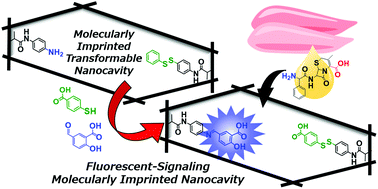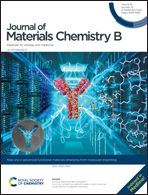A molecularly imprinted nanocavity with transformable domains that fluorescently indicate the presence of antibiotics in meat extract samples†
Abstract
In this study, we aimed to create synthetic polymer receptors with the fluorescence signalling ability, using molecular imprinting, precisely designed template molecules, and site-specific post-imprinting modifications, which can mimic conjugated proteins and are capable of specific molecular recognition, and wherein successful binding can be indicated by a change in fluorescence. A molecularly imprinted APO-type nanocavity with a reconstructable domain was prepared by co-polymerisation of a template molecule containing cephalexin conjugated to polymerisable groups via a Schiff base, a disulphide bond, and a cross-linker, followed by hydrolysis of the Schiff base and a disulphide exchange reaction. Fluorescence-based indication of binding was devised by the Schiff base formation reaction with 4-formylsalicylic acid, and the interacting site was introduced via a disulphide exchange reaction with 4-mercaptobenzoic acid, yielding a multifunctional mature (HOLO)-type molecularly imprinted nanocavity. The ability to indicate binding events using changes in the fluorescence of the HOLO polymer was investigated, and it was revealed that the target antibiotic cephalexin can be selectively detected in aqueous media with high affinity (Ka = 1.1 × 104 M−1). Furthermore, the proposed sensor exhibited the potential to detect spiked cephalexin in chicken extracts with a limit of detection of 18 μM (1.3 ppm). The proposed fluorescence-sensing system based on molecular imprinting and post-imprinting modification is expected to enable the development of advanced materials for the specific detection of trace antibiotics in complex samples.

- This article is part of the themed collection: New era in advanced functional materials emerging from molecular imprinting and related techniques


 Please wait while we load your content...
Please wait while we load your content...